14 Seasonings That Will Take French Fries To The Next Level

The unassuming combination of potato sticks sizzled in oil has fans across the globe. Though their most probable origin is in Belgium, french fries are not confined to regions or belong only to fast food joints, as you'll find them even at classy establishments, albeit in a slightly posh form. Fries are something we usually eat out, but there's nothing more satisfying than throwing a batch in the fryer and eating them steaming hot.
The discussion about the best homemade french fries usually revolves around selecting the best potatoes and a technique that delivers restaurant-quality potatoes praised for the ideal ratio of tenderness and crispiness. What we typically skip in this equation is the seasoning -- the step that delivers most flavors to your fries. You probably do the generous handful of salt or a whiff of pepper, but in this article, we think outside the box and find flavors and seasoning that have the power to transform and give your fries a total makeover.
The suggestions include pantry staples that you probably never considered and regional favorites that deserve more international attention. Regardless of where they come from, all the items have one thing in common: to create the best version of fries you'll ever try. And please, don't reserve these only for homemade fries; sometimes, even restaurant versions need a little help.
Read more: 16 Little-Known Facts About Salt
Ranch
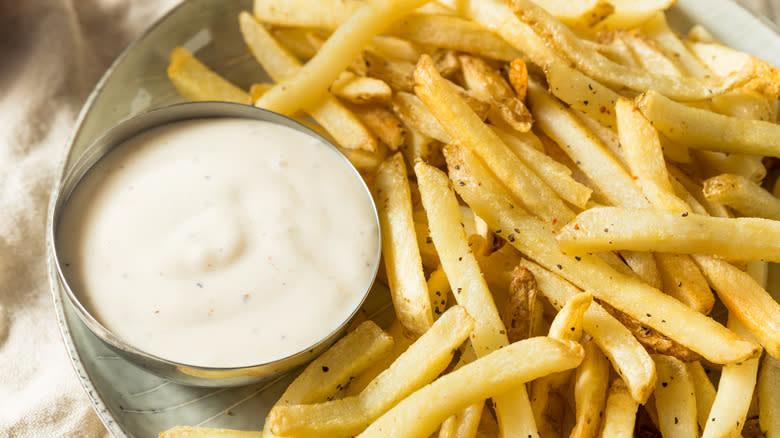
Ranch is one of America's favorite dressings. Classic ranch uses mayo and buttermilk as the base and then brings in flavors with various herbs. It won over the public with its mild herbal flavor and consistency that was perfectly smooth and rich with the additional bonus of a great all-purpose condiment. The texture was perfect for salads, and eventually became a dip of choice for fries, chicken wings, and even pizza. Ranch is also available as a powdery seasoning that you can use to flavor chicken, potatoes, or sauces, but you should also add it to your fries.
Typically, this mix combines buttermilk, onion, and garlic powder enriched with herbs and accompanied by various flavor boosters. Store-bought varieties have a uniform consistency, which makes them ideal for fries. Add the seasoning before or after frying, or do both. For an extra ranch kick, reserved only for true aficionados, serve the fries with ranch as the dipping sauce. If you are not a fan of the store-bought version, you can always mimic the original flavors at home by combining buttermilk, garlic, and onion powder with salt and a mix of dried herbs, such as parsley, tarragon, and dill.
Za'atar
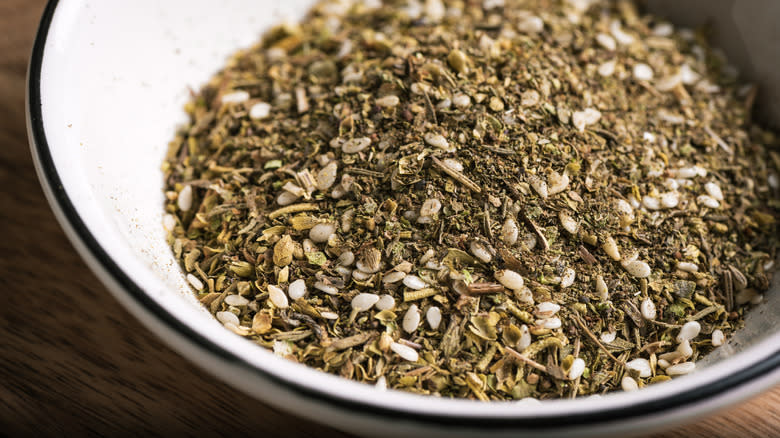
Za'atar is a spice blend with Middle Eastern origins. The name refers to a potently aromatic local herb known as bible hyssop, which was used in the original version of the mix. Confusingly, many blends that are available today skip the za'atar herb but use the name. There are no definite rules on what goes into the za'atar blend, but some of the most common elements you'll probably come across are thyme, marjoram, oregano, sumac, sesame seeds, and salt.
What you can generally expect from za'atar is a medley of aromas and flavors ranging from herbal, earthy, sour, smoky, and toasty. In the Middle East, you'll see za'atar mixed with olive oil and served as a dip, sprinkled on top of bread, and generally used as a multipurpose seasoning that gives everything a nice flavor boost. As it is truly a versatile spice blend, you can use za'atar on top of yogurt and season salads, potatoes, or meat, but we also recommend pairing it with your next batch of fries.
Za'atar is best added after frying. When your potatoes are ready, generously sprinkle them with your favorite za'atar mix, taste them, and add more salt if necessary. Za'atar will also work with fries from the oven. You can serve these fries with a dip of choice, but if you want to stick to the regional topic, you should serve them with a tahini-based sauce.
Old Bay Seasoning
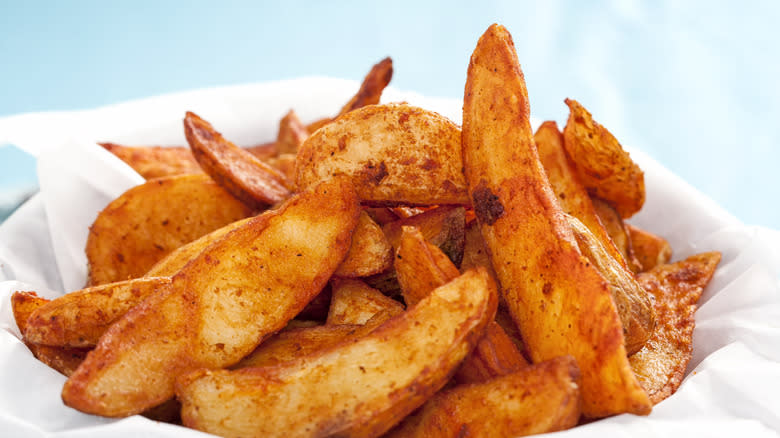
Old Bay seasoning doesn't need much introduction. This seasoning blend was invented sometime in the late 1940s and is one of the staples in American kitchens. Originally intended to be paired with plentiful crabs from the Chesapeake Bay, it soon proved to have potential for more. The exact ingredients inside the original seasoning or their ratio have never been disclosed, but the company lists celery salt and paprika, while it is also speculated that the blend also includes cayenne pepper and warming sweet spices such as cinnamon and cloves. What we know for sure is that this iconic blend delivers a ton of sweet, smoky, and spicy flavors and aromas. Besides seafood boil, you can add it to sauces, dips, and crab cakes, but it also does well as a seasoning on top of corn and potatoes, including classic fries.
For the classic deep-fried version, add the seasoning immediately as the potatoes leave the fryer. If you are making oven-baked fries, you can generously coat the potatoes with oil and the seasoning before they go into the oven. Feel free to combine Old Bay seasoning with salt or any other spice you prefer.
Furikake

For those less familiar with Japanese cuisine, furikake is best described as a nutty and crunchy condiment used as a finishing touch on top of ramen, rice bowls, or as a garnish on onigiri (nori-wrapped rice cakes). Furikake was invented at the beginning of the 20th century with the primary purpose of acting as a nutritious condiment for the whole nation, as the traditional diet mainly depended on white rice. Nowadays, these blends are primarily consumed due to the delicious combination of savory flavors.
Typical furikake combines fish flakes, nori seaweed, and sesame seeds, sometimes with other ingredients thrown in the mix. It results in a lightly crunchy condiment with a distinctive nuttiness and subtle seafood flavors that can work with a variety of less traditional dishes, including classic fries. Furikake should be the finishing seasoning on top of the fries. As it can be chunkier than your standard seasonings and condiments, make sure to add it while the fries are oily and fresh so it can better adhere to the surface.
Paprika
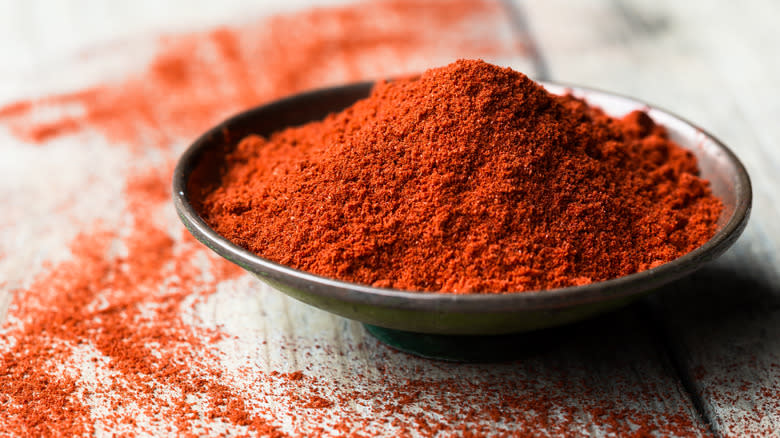
Paprika is a seasoning spice made with dried and ground peppers. It can vary in color, flavor, and heat, usually due to the type of pepper used and whether the blend uses other parts of the plant, namely the seeds that deliver the most heat. Some varieties use smoked peppers to create distinctive smokiness that translates into dishes, providing a subtle smoky note. Paprika is usually finely textured, and though the color varies, most varieties have a lively red color that will affect the color of the dish where it's used. Paprika is produced in many countries and regions, but Hungary and Spain remain the most important producers.
Paprika can transform dishes by providing depth, complexity, and zest, and it does the same to a batch of your regular fries. Choose the variety you prefer, and feel free to mix it with other spices. For the traditionally fried version, add paprika after frying while the potatoes are still hot to soak up all the spice. For the oven-based version, season the fries before baking. You will probably want to add salt to your paprika-seasoned fries.
Chicken Salt
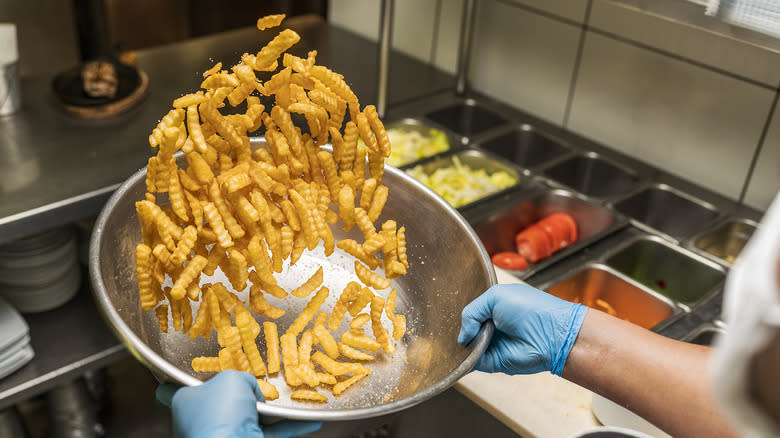
Chicken salt holds a legendary status in the land down under, but other parts of the globe are unfamiliar with this umami-laden seasoning. It was invented in the 1970s when Peter Brinkworth combined salt and spices to create a seasoning blend that he would use to flavor rotisserie chicken. The name was crafted as a reference to its original purpose, but the blend is actually not made with chicken. While the original version combined dry chicken stock, celery, paprika, garlic, onion, salt, and MSG, various available blends now use different ingredients, but they all aim to deliver a complex savory flavor. Though the mix was initially reserved for chicken, it was later repurposed into a multipurpose condiment, and fries, or chips as they are called in Australia became a particularly suitable partner.
You first want to fry the potato sticks and then generously coat them in chicken salt. The blend will deliver a lot of saltiness, so no other additions are necessary. Though it has become more available outside Australia, if you can't get your hands on pre-packed blends, you can try whipping up the homemade version and perhaps better adjust it to your taste.
Malt Vinegar
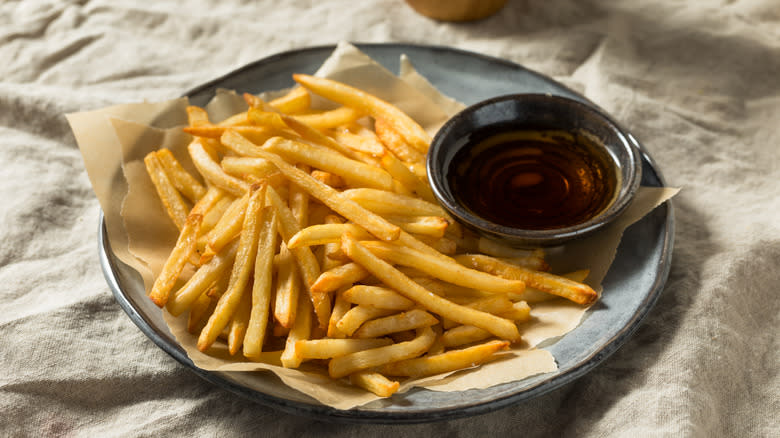
Malt vinegar might sound like an unusual seasoning for fries, but this pairing is something you will usually only find in Canada or the U.K. This punchy vinegar is typically made with malted barley in the process in which the grains are germinated, dried, and brewed into an ale that goes through an additional fermentation to create vinegar. The result is a dark-colored liquid brimming with zesty, nutty, and savory nuances. Malt vinegar is something you will usually find at the legendary fish and chips shops specializing in this classic British fare, as it's an ideal condiment with fries and crispy fish.
Malt vinegar is a seasoning that is usually added after frying. It is typically sold in bottles, and at fish and chips shops, it is already placed on the table so you can generously drizzle it on top of fries. You can, however, use it to season raw potatoes if you're whipping up the oven-baked version. Malt vinegar is a unique seasoning that will deliver a ton of flavor to fries. It can't really compare to any other seasoning in terms of the toasty and nutty notes it will bring to the table. If you're up for trying this combo, you'll typically find malt vinegar in the condiment section.
Citrus Zest
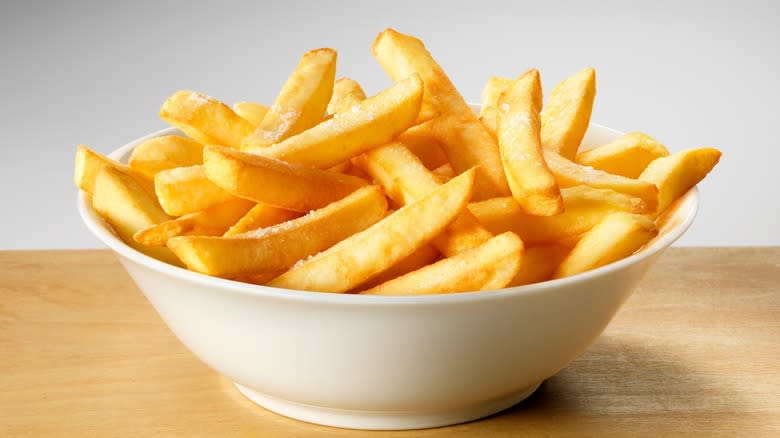
Don't reserve wonderfully aromatic citrus zest only for cakes and creams. This convenient staple can make an excellent addition to savory dishes. Lemon and lime zest can brighten any marinade, while orange zest can deliver a tangy kick with a lot of warming sweetness. Another great idea is adding a pinch of citrus zest to your homemade fries. We recommend sticking to lemon or lime as the most suitable options, but no one is stopping you from experimenting with orange zest.
Add the zest as the final step when your potatoes are already fried. It is best to use freshly grated zest as it has the cleanest and most potent aroma, and you won't need much to give your fries an entirely new character. Citrus zest is also incredibly versatile and can be paired with other condiments. Salt is mandatory but think about adding a sprinkle of freshly ground pepper or a touch of paprika to amp up the zingy notes. Citrus zest would also be an amazing partner with dry or fresh herbs. Mediterranean mixes with thyme or oregano would pair with lemons, while cilantro makes an excellent match with lime.
Curry Powder
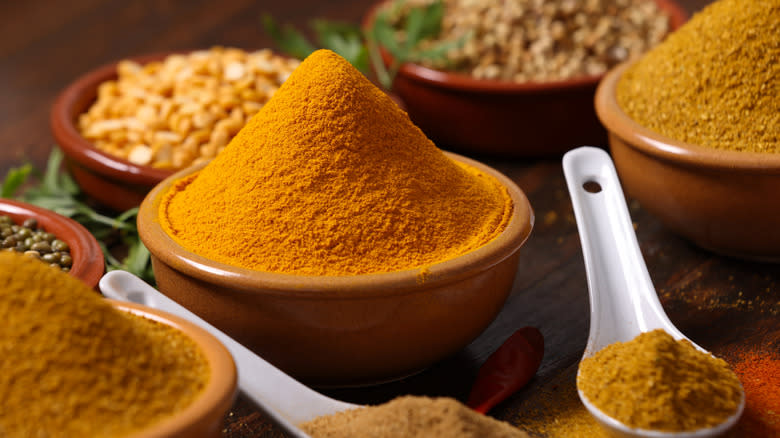
Curry powder is now a common sight in home kitchens and has long surpassed the original intention to be reserved for Asian-inspired fare. This wonderful spice blend is available everywhere, and every larger supermarket will carry at least one variety. Curry powder comes in various colors and flavors. As it's a spice blend, the exact ingredients can vary, but you can usually expect a mix of coriander, cumin, turmeric, and pepper. Sweet spices such as cinnamon and cardamom are also not uncommon. Of course, the exact ingredients and the ratio will affect the final flavor of the blend, but it usually displays a mix of earthy and spicy aromas and flavors. Curry powder goes exceptionally well with potatoes, and though the roasted version is already familiar to most, using curry powder as a seasoning on top of fries has yet to become a tradition.
Curry powder has the ideal consistency to act as a seasoning on fries. Ideally, you can season the fries beforehand, but you can also dust the potatoes after frying while they are still warm and sticky from the oil. You can also add the powder to oven-baked fries, but do this with oil-coated potatoes before you put them in the oven and reserve some to add as garnish.
Italian Seasoning
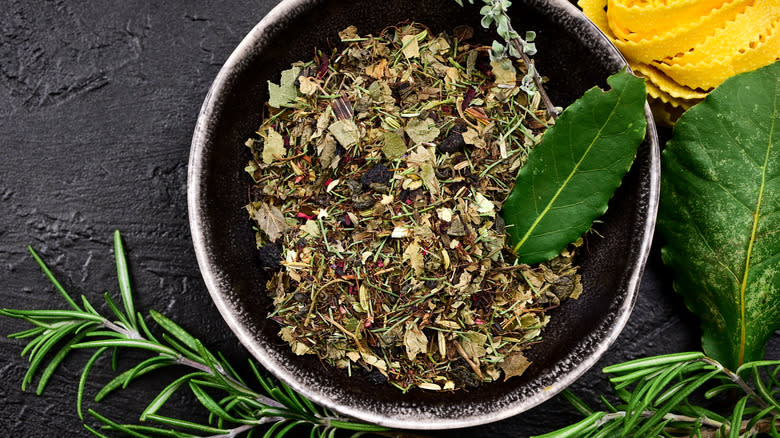
Italian seasoning has become a go-to option whenever we want to add a touch of Mediterranean feel to savory dishes. The blends vary depending on the producers, but the packets usually consist of a combination of various dry herbs. The most common choices are oregano, basil, marjoram, rosemary, and thyme. All the elements are finely ground or chopped to better blend into various dishes. Italian seasoning is often added to marinades and dressings. It is an excellent seasoning on top of chicken and pork, and as it goes well with potatoes, you can count on it as a fantastic addition to your fries. Use the seasoning with deep-fried or oven-baked versions to pack them with tons of aromatic and herbaceous notes.
If you pair your fries with Italian seasoning, the combination will call for an equally scrumptious herbal dip. To stay within the Mediterranean theme, try to use yogurt-based dips and enrich them with lemon zest and herbs, but even ranch or classic mayo can make an excellent side to these fragrant fries.
Togarashi
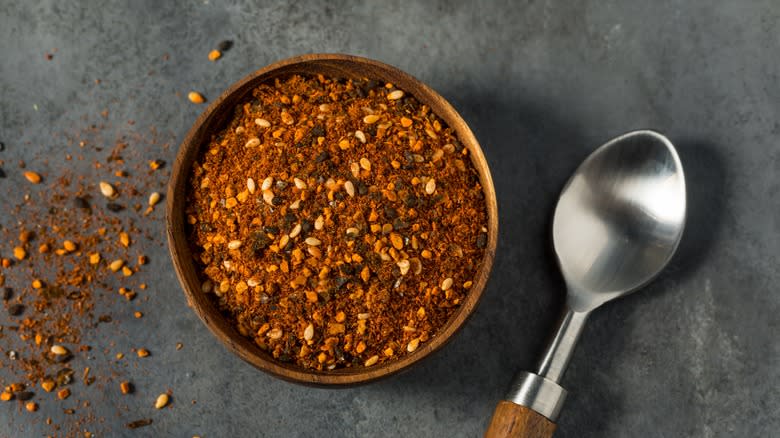
Togarashi comes from Japanese tradition and is probably one of the less familiar items on the list. Commonly referenced as the seven-spice blend, this combination has been popularized outside its native country. If you get your hands on some of it, try not to reserve it only for traditional use with noodle soups and rice bowls. This wonderfully aromatic and complex mix will be amazing as a seasoning on top of fries.
Togarashi has a long tradition in Japan, and it's assumed it first appeared in the 17th century. The ingredients can vary, but the blend usually uses chili peppers as the base and then enriches the combination with sansho pepper, black and white sesame seeds, orange zest, ginger, and nori seaweed. The brands also create signature blends by adding ingredients such as yuzu and other seeds. In Japan, togarashi is usually used as the final seasoning on top of dishes to provide more flavor and complexity.
If you want to add it to your fries, it's better to follow the traditional technique and sprinkle togarashi when you take the potatoes out of the fryer. You might also want to add some salt to balance out the flavors.
Taco Or Fajita Seasoning
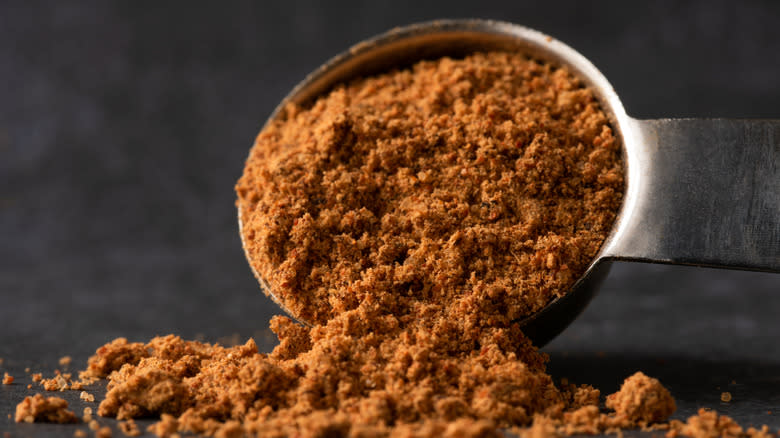
If you want to add some Mexican flair to your fries, the most convenient thing to do is to reach for taco or fajita seasonings. These blends are ubiquitous on supermarket shelves, and you most likely have a bag or shaker stashed on your spice rack. Besides their apparent use in tacos and fajitas, these blends can work in every dish that calls for Mexican flavors, including chili, tortilla, or burritos. You can add them to sauces or pair them with chicken or beef, but these blends can also provide depth and complexity if you're working on meat-free Mexican specials. If you're a huge fan of these mixes and you don't want to wait till the next time you assemble a Mexican-style dish, try to repurpose these blends. Our suggestion is a wonderful partnership with french fries.
Typically, these mixes are made with a blend of hot and sweet spices. The brands usually use a combination of chili, onion and garlic powder, salt, and cumin, but the exact ingredients and ratio can vary. Taco seasoning is usually more spice-forward than the fajita version. Of course, you can try to whip up these seasonings at home if you have most of the ingredients. This way, you can customize the blend and adjust the heat to suit your taste.
Sumac
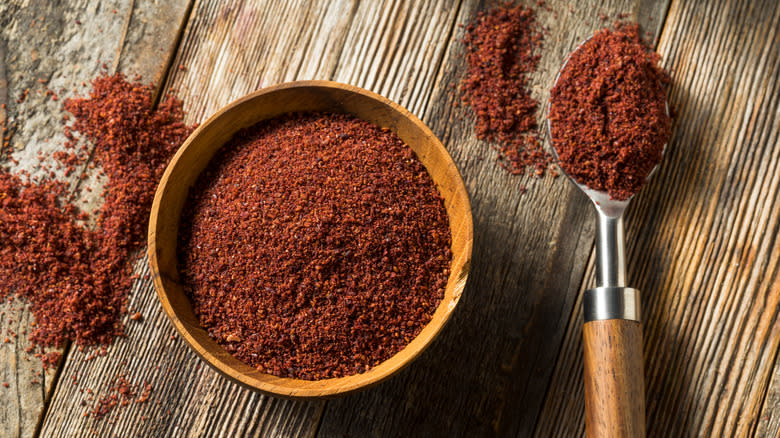
Sumac is a wonderful Middle Eastern spice packed with nuanced aromas and flavors. The spice comes from a local plant with clusters of red sumac berries that are collected and usually ground into a powder that can be incorporated into other dishes. Sumac has a deep red, almost burgundy color and is a pantry staple in many Middle Eastern kitchens. It is a multipurpose spice that makes amazing salad dressing, but it also goes well with fish and chicken and makes excellent rubs and marinades. It can also be sprinkled as garnish and a seasoning spice. Besides these more traditional uses, sumac also has the potential to become a fantastic seasoning on top of fries.
Sumac has this unique, almost tangy character with a touch of floral, earthy, and smoky notes that will blend well with the mild flavor of the potato. These fries will call for salt as an additional seasoning, creating a beautiful combination of flavors that will take your fries to a whole different level.
Harrisa
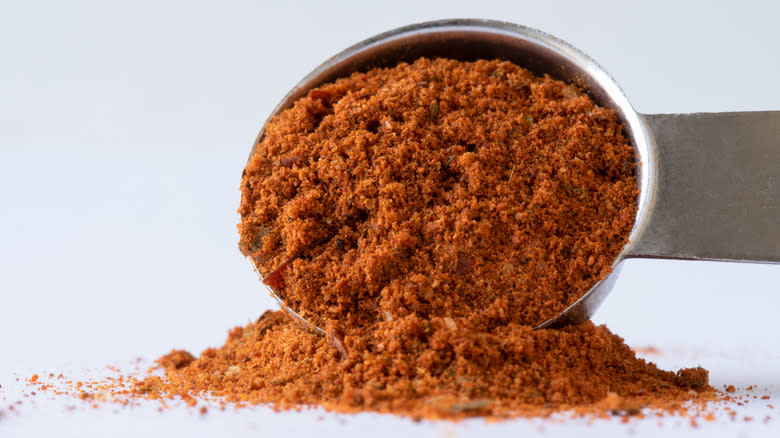
The term harissa is usually a reference for a thick and spicy paste traditionally used in several North African cuisines. Best classified as a chili paste, harissa uses chili peppers as the base ingredient. The peppers are ground and enriched with garlic, olive oil, and a selection of spices such as cumin and coriander, resulting in a complex blend of spicy, sweet, and earthy flavors. These pastes are not uniform and often differ in color, texture, and heat, ranging from runny, thick, and chunky to perfectly smooth versions with various degrees of spiciness. Besides the original form, you can also find a dry spice blend typically labeled harissa powder. This dry form uses dry chili peppers and tries to mimic the flavors of the traditional harissa paste. If you are a fan of either of these, you should follow our suggestion and pair them with fries.
Both the paste and the powder can be used as a seasoning for fries. The paste can be used as a thick batter-like coating that will give the potatoes an extra spicy crunch, while the powder can be used before frying. However, it also works as a seasoning spice for a freshly fried batch of fries.
Read the original article on Mashed

